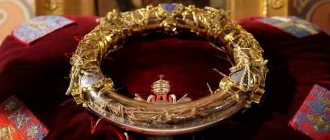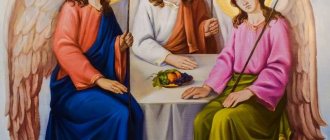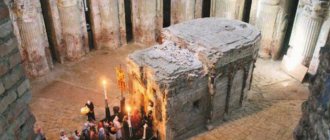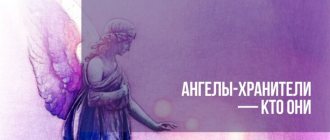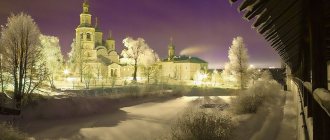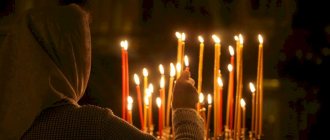In many Orthodox prayers we often hear words such as Cherubim and Seraphim. For example, in the prayer “It is worthy to eat” we see the following words: “...The most honorable Cherub and the most Glorious without comparison Seraphim...”. What it is? Who are Cherubim and Seraphim? What is their difference?
An ancient icon depicting the Cherubim and Seraphim - the Heavenly Army of God, about which we know very little
Of course, it’s impossible to answer in one word who it is and what it is. Let's look at this in more detail. How can we even find out about all this? Theologians learned about these creatures by reading scripture. But you can read about them in the Old Testament, and these are also revelations of monks, to whom they appeared in visions.
Cherubim and Seraphim are one of the main angelic ranks
Cherubim and Seraphim are one of the main angelic ranks. Each Cherub and Seraphim performs a specific function. Images and pictures of them are extremely rare, because no one knows what they look like.
There are three ranks in the Heavenly Hierarchy; it can be represented as an ordinary ladder. At the very top is the Almighty, and the following steps are for the angels:
- 1st step - is closer to God. And the Seraphim sit on it;
- 2nd step - cherubs;
- 3rd step - thrones.
There are three ranks in the Heavenly hierarchy. In this photo it is presented completely differently - in the form of the Cross of the Lord. At the very top is the Almighty, and the next steps are for the angels
The very first highest level after the Almighty - Seraphim
Let's look at each step separately to understand what they actually mean. The very first significant step, after the Almighty, is the Seraphim.
They are first mentioned in the book of the prophet Isaiah. Here's what he writes:
Isaiah
Prophet
“...In the year of the death of King Uzziah, I saw the Lord sitting on a throne, high and exalted, and the borders of His robe filled the whole temple. The Seraphim stood around Him; each of them had six wings: with two he covered his face, and with two he covered his feet, and with two he flew... And they called to each other and said: Holy, Holy, Holy is the Lord of hosts! the whole earth is full of His glory! And the tops of the gates shook at the voice of those shouting, and the house was filled with incense...”
From this we conclude that Seraphim is a creature with six wings. They covered their faces with two wings, two more covered their entire body, and a third pair was needed for flight. It was believed that the Seraphim covered themselves with their wings because they emitted a very bright light, and this in turn could blind people.
Seraphim is a creature with six wings. They covered their faces with two wings, two more covered their entire body, and a third pair was needed for flight.
But it was the prophet Isaiah who was able to see the Seraphim, because this happened by the will of God. What happens next? Isaiah writes:
Isaiah
Prophet
“...And I said: Woe is me! I'm dead! for I am a man of unclean lips, and my eyes have seen the King, the Lord of hosts. Then one of the Seraphim flew to me, and in his hand he had a burning coal, which he took with tongs from the altar, and touched my mouth and said: behold, this has touched your mouth, and your iniquity is taken away from you, and your sin is cleansed ... " .
The prophet himself was very surprised how he could see the King of the Lord himself if he was also mired in his sins. In response to his question, one of the Seraphim appeared to him.
On many canvases the Seraphim are depicted with a human face. An example of such a canvas can be seen in the photo below.
Sometimes the Seraphim simply hold the throne on which the Lord God himself is located. Such icons are always painted in red or crimson tones, because the Seraphim are, as it were, associated with fire and love. It was believed that they were called upon to give heat to ordinary people and subjugate them to their will.
Sometimes Seraphim on icons simply hold the throne on which the Lord God himself is located
According to Dianisius the Areopagite, the heavenly army was always in constant motion, around everything divine.
It is the Seraphim who inform people about God, and they also call on people to keep the commandments of the Lord. But the most important thing that the Seraphim do is convey to the other ranks what God commands them. It is from them that others carry out their orders.
Seraphim also cleanse the souls of people from sins. They very easily and simply burn all souls, while destroying all human sins. In fact, the Seraphim can be considered one of the most powerful and mysterious creatures of God.
Notes
- also 1 Kings.
- ↑ Midrash Bereshit Rabbah XXI
- Tanna debe Eliyahu Raba I
- Talmud, Chagiga 13b
- ↑ Midrash Tehillim XVIII, 15; Midrash Shir Ha-Shirim Rabbah to 1:9
- Talmud, Yoma 21a
- Talmud, Yoma 54b
- Talmud, Yoma 54a
- Talmud, Chagiga 12b
- Midrash Kohelet Rabbah X, 20
- Midrash Tadshe, ed. Epstein, page 15
- see, for example, Sifre, on Deut. 3:24
- Wed Zohar on the Book of Exodus, chapter Bo, 43a
- Adolf Jellinek, Auswahl Kabbalistischer Mystik, page 3
- ↑ - article from
- Skaballanovich M. N. The first chapter of the book of the prophet Ezekiel. Experience of explanation. - Mariupol: 1904. - P. 29.
- The works of our holy father John Chrysostom, Archbishop of Constantinople, in Russian translation. SPb. 1900. T. 6 P. 751.
- Skaballanovich M. N. Decree. op. P. 30
- “The Book of the Secrets of Enoch” XIX, 6; XX, 1
- Book of Enoch, LXX, 7; Wed LXI, 10
- ↑ Talmud, Sukkah 5b
- This is due to the comparison of two passages in the prophet Ezekiel (1:10 and 10:14): in the first passage it is said that the creatures of the heavenly chariot had four faces: a man, a lion, a bull and an eagle, and in another place it is said that these four faces were: cherub, man, lion and eagle. Thus it follows that cherub = bull.
- ↑ Jewish Encyclopedia, Ed. Islands for Scientific Jewish Publishing. and Brockhaus-Efron. St. Petersburg: 1906—1913; reprint: M.: Terra, 1991. ISBN 5-85255-057-4.
- Talmud, Chagiga 13b
- Jewish Antiquities, VIII, 6 § 5; VIII, 3, 3
- Philo of Alexandria, De Cherubim, VII, X; De Vita Mosis, III, 8
- Maimonides, Mishneh Torah, section “Fundamentals of the Torah” II, 7)
- Maimonides, Guide of the Perplexed IIΙ, 45
- .
The next highest level after the Seraphim is the Cherubim
The next step after the Seraphim is the Cherubim. In the book of Genesis, there is a record that states that one of the Cherubim is a guardian. It was believed that he stood and guarded the entrance to heaven. King David said that God uses Cherubim as carriers, this is how he flies around his possessions.
The purpose of the Cherubim is to convey the wisdom of God to people. They tell people about God, and also teach people to live a calm and righteous life. They not only teach ordinary Christians, but also teach those who are at the lowest levels of the heavenly hierarchy.
Cherubim appeared approximately on the third day after God created the world. And they were the creatures that settled on earth.
In the images, Cherubim, as well as Seraphim, are depicted with a human face and wings and six wings
Images of Cherubim can be seen on some icons and statues. On them, they, like the Seraphim, are depicted with a human face and wings. In some images you can see a lion's face. And some ancient sources indicate that Cherubim were even depicted in the form of bulls with wings.
Images of Cherubim can be seen on some statues, in which they are also depicted with a human face and wings
If you believe the European legend, which states that when a person falls asleep, his body whispers to his soul about what was experienced during the day. Then the soul transmits the information to the Guardian Angel, and he to the Cherub.
After him, the information goes even higher, to Seraphim, and from there directly to God. This is how the Lord finds out what a person has done during the day.
Cherubim - praise and glorify God in their hymns and songs.
Angels have always been considered the most intelligent and wise creatures. For example, John Chrysostom believed that the Cherub consists of an eye, which is why it sees everything and knows everything about a person. This is the only way he conveys all the information to God.
But, unfortunately, there is no exact description of what they look like. There are only two criteria - wings and faces. It was assumed that it was the Cherubim that should have been located on the lid of the Ark of the Covenant, since they simultaneously symbolized the throne of the invisible Lord and served as protection for the entire Ark.
Cherubs in art - a common misinterpretation
Biblical motifs, in addition to the classical iconography that existed at the dawn of Christianity, aroused great interest among the creators of the Renaissance. Then many artists, some out of fear of the Inquisition, some out of a sincere desire to reveal from a new side the ideas of sensuality in Christianity, preferred to use scenes from the Old Testament in their paintings. For the first time, plump babies with wings appeared on them. They were depicted in paintings, statues with their participation, and frescoes were made.
Now that the art of the Renaissance is available to everyone, many people unknowingly call these kids cherubs. But they have nothing to do with the angelic order, close to God after the seraphim. This misconception is found in Russian-speaking countries.
Such a baby is called putto, or putti - when he is not alone. They appeared due to a mixture of interest in ancient culture and the Christian religion. Putti play a complementary role, accompanying the main object of art. Their drawing was entrusted to apprentices and apprentices, the artist carried out the main plot of the picture. The famous painting “The Vision of the Prophet Ezekiel” by Raphael. There this angelic rank is depicted as four flying creatures - an angel, a calf, an eagle and a lion, on which God sits.
Cherubim occupy an important place in modern Christianity. This is evidenced by cherubic incense in church magic and other aspects. One of the main services performed in Orthodox churches is called the Cherubic Song, and begins with the words “like the cherubs.” But not a single cherub in any legend had its own name and purpose. This allows individuals to doubt the importance of these angels in the divine world.
Thrones were very often described as chariots with wheels of fire
So, we figured out what Seraphim and Cherubim are. And what is at the lowest level? Thrones - what is it? Thrones were very often described as chariots with wheels of fire. Each of them has 4 wings.
A little later, in church literature it was indicated that the image was similar to the appearance of Seraphim. The thrones were named for a reason; it was believed that the Lord himself sat on them from time to time.
The thrones were named for a reason; it was believed that the Lord himself sat on them from time to time. Very often they were called - God-bearing
Thrones also serve to transport God, which is why they are often called God-bearing.
The middle level after the Angels consists of Dominances, Powers and Powers
The average Angelic hierarchy consists of three more ranks: Dominion, Strength and Authority. Dominions govern, in essence, the subsequent ranks of Angels. Dominations teach you to control your feelings, enslave your flesh to the spirit, and also dominate the will in order to defeat temptations.
The forces fulfill the will of the Lord. They work miracles and send grace to the saints of God. They also help in carrying out various obediences, giving strength and spiritual courage.
The authorities are taming the forces of the devil. They help people fight demonic temptations, in the fight against bad thoughts, confirm ascetics, and also protect them.
The lower hierarchy includes three more ranks: Principalities, Archangels and Angels. The principles govern the lower Angels. They rule the universe, protect human countries and peoples.
This is what the Highest, Middle and Lower ranks in the Heavenly Hierarchy look like schematically
Archangels announce the great and the glorious. They help people discover the secrets of faith, as well as the prophecies of God. They also help strengthen the holy faith in people.
Angels are the creatures closest to people - they help people take the right path.
Angels are the creatures closest to people. They help a person take the righteous and true path. They protect all Orthodox Christians, never leave and are always ready to help if we ask for it.
Above all nine ranks stands the Holy Archangel Michael. He is a faithful servant of God. In Orthodoxy, the Council of the Archangel Michael and other ethereal Heavenly Powers is celebrated. Archangel Michael took part in almost all Old Testament events.
Above all nine ranks stands the Holy Archangel Michael. He is a faithful servant of God
On the icons, Michael is depicted trampling underfoot the devil. In his left hand he has a green date branch, and in the other a spear with a white banner, on which is inscribed a scarlet cross.
So, Cherubim and Seraphim are the Angels closest to the Lord. They are the very creatures that bring people holiness and wisdom from God. That is why very often we hear about them in prayers or chants.
Only a few excerpts from Orthodox literature show us what kind of creatures they were. As we can see, these images are very interesting and, nevertheless, very mysterious.
By leaving a comment, you accept the user agreement
Archangels Edit
Archangel
(Greek αρχι- - “chief, senior” and άγγελος - “messenger, messenger”) - in Christian ideas, the senior angel. In the system of the angelic hierarchy of Pseudo-Dionysius the Areopagite, this is the eighth of the nine ranks of angels. In the canonical books of the Bible, only Michael is directly named as an archangel, but according to the traditions of the church, there are several archangels.
According to the classification of angels set out in the work of Pseudo-Dionysius the Areopagite (5th - early 6th centuries) “On the Heavenly Hierarchy”, Archangel is the name of the second rank in the third, lowest rank of the angelic hierarchy (1st rank - angels, 2nd - archangels, 3rd - start). According to another, more ancient classification - in the Jewish apocrypha “Book of Enoch” (2nd century BC) - there are seven Archangels:
- Michael is the main Archangel,
- Gabriel is the guardian of paradise and the leader of the spirits who help people.
- Raphael - placed over the spirits of people,
- Uriel - ruler of the heavenly bodies,
- Raguel - punishing the world of luminaries,
- Sariel is the leader of the spirits that seduce and draw people into sin,
- Remiel - placed over souls ascending to God.
Probably the seven Archangels of the Book of Enoch correspond to the seven Amesha Spentas of the Zoroastrian pantheon and the seven planetary spirits of the Babylonians. According to the mystical traditions of Judaism, each archangel is connected to one of the planets. The seven Archangels, as leaders over myriads of angels (heavenly hosts), are also called archangels
.
The doctrine of seven angels is also found in the canonical books of the Bible. In the Book of Tobit: “I am Raphael, one of the seven holy angels who offer the prayers of the saints and ascend before the Glory of the Holy One” (12:15). In the Apocalypse: “the seven stars are the Angels of the seven churches” (1:20). The doctrine of the council of seven Archangels with specific names appears in the Middle Ages in the 15th century, this description was made by the Franciscan Portuguese monk Amadeus Mendes da Silva († 1482), he learned the names from his own revelation. In the Middle Ages, the cult of seven angels appeared in the Catholic Church and churches were built in Rome, then in Naples. Until the end of the 17th century, this teaching about a council of 7 archangels with specific names was not in Orthodoxy, both in iconography and in hagiography (Great Menaions of St. Macarius of the 16th century, Lives of the Saints Tulupov of the mid-17th century) - no. The teaching with names from the revelation of Amadeus of Portugal was included in the lives of the saints by Demetrius of Rostov under the date March 26 in the 1700 edition. In the Catholic Church itself, the doctrine of seven angels, with specific names, was rejected and returned to the worship of only three angels: Michael, Gabriel and Raphael, only to those names that were allowed to be venerated by the Roman Council of 745 under Pope Zechariah. Only these three names are in the canonical books of the Bible. The Council of Rome in 745 defined: “Nos autem, ut a vestro sancto apostolatu edocemur, et divina tradit auctoritas, et non plus quam trium angelorum nomina cognoscimus, id est Michael, Gabriel, Raphael: alioqui de mysterio sub obtentu angelorum demonum nomina introduxit.” (But we, as the holy apostolic ministry teaches us and gives us Divine authority, do not know more than three names of angels, that is, Michael, Gabriel, Raphael: otherwise the secret of the existence of the names of angels and demons would be revealed.) The names Barachiel and Jehudiel are not in the Holy According to the tradition of the Church, these names are from the revelation of Amadeus of Portugal. The first name - Barachiel - is found in the Jewish apocrypha in the “Book of Heavenly Palaces” (between the 2nd and 8th/9th centuries) - chapter 14, 17: “Baraki*el (Barachiel), who controls lightning,” but the name Yehudiel does not appear nowhere at all, except for the revelation of Amadeus.
If you believe solely in the words of the Bible, then Michael is an archangel, Gabriel is an angel (according to Orthodox hymnography, he is an archangel), Raphael is an angel. According to the non-canonical book of the Bible, the Third Book of Ezra, Selaphiel and Uriel are only angels, and not archangels or cherubim or seraphim.
In the Orthodox Church you can see images of the following Archangels: Michael, Gabriel, Raphael, Uriel, Selaphiel, Jehudiel, Barachiel and Jeremiel. Sihail, Zadkiel, Samuel, Jophiel and many others are also known.
The celebration of the Council of the Archangel Michael and other ethereal heavenly powers is celebrated in the Orthodox Church on November 8 (21). Its establishment is associated with the decision of the Council of Laodicea (c. 343), which took place several years before the First Ecumenical Council and condemned as heretical the worship of angels as creators and rulers of the world.

